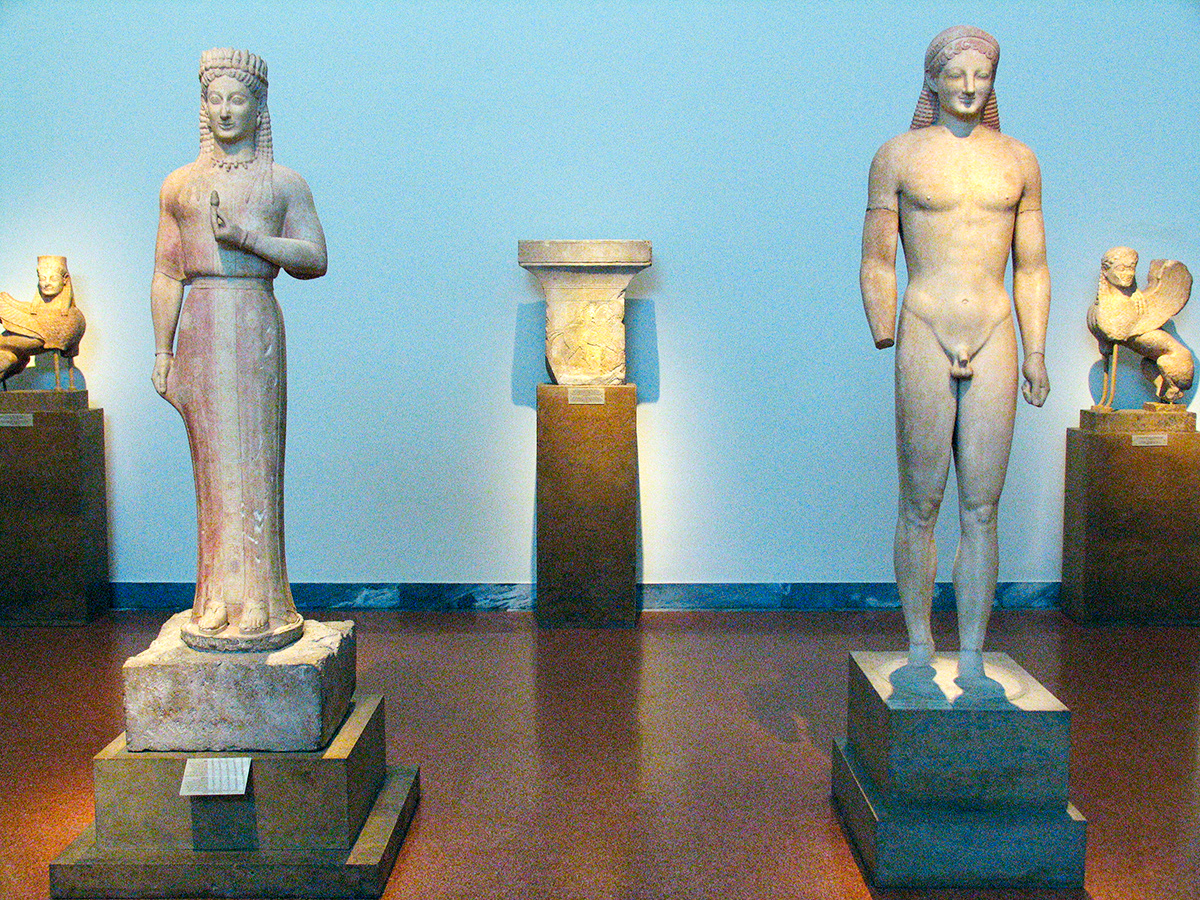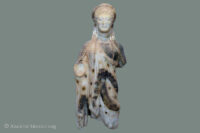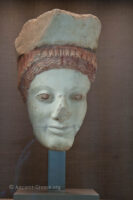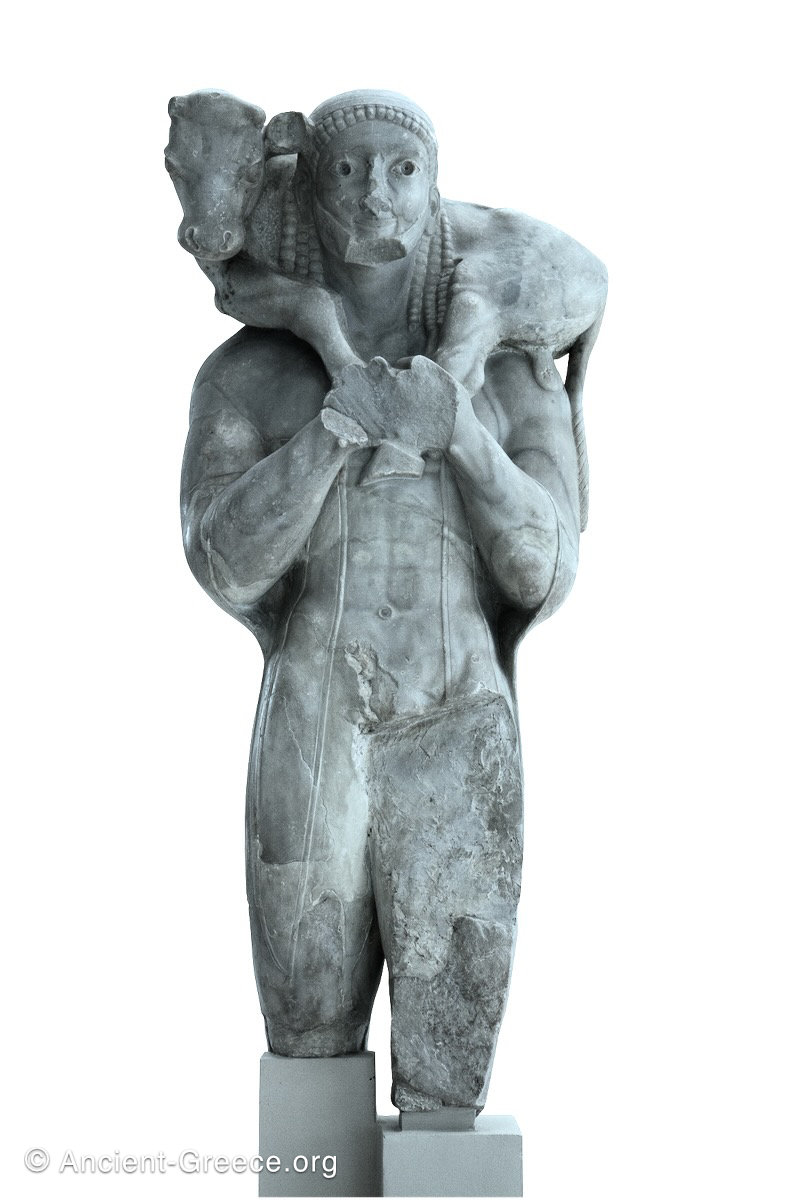
On this page:
Kore (κόρη = maiden. Plural: κόραι, korai) refers to statues depicting female figures, always of a young age, which were created during the Ancient Greek Archaic period (600 – 480 BCE) either as votive or commemorative statues. Wealthy patrons commissioned them either to serve the deities in place of the patron, or as less often was the case, to become commemorative grave markers for members of a family.
Many times their base (and sometimes their dress) was inscribed with a short paragraph documenting the statue’s function, the patron, and the artist. According to the most accepted interpretations of the archaeological evidence, kore statues never represented deities.
A great deal of kore statues have been unearthed on the acropolis, most dating back to the beginning of the 6th c. BCE. In fact the Acropolis Museum collection tends to monopolize the kore discourse because of the large number and breadth of stylistic variety that have been unearthed at this site. Kore statues however have been found throughout the Greek world.
Difference Between Kore and Kouros
Korai statues are the female equivalent of Kouros. There are several distinct differences between the two, with the most significant one being the fact that kouros statues were almost always portrayed in the nude, while kore were always clothed. Consequently, when studying the statues, we tend to focus on the development of anatomical representation in kouros, and on the development of the dress for the kore along with the facial expression.

Most of the kore statues are either life-size or a little smaller, and were developed with the same techniques and proportional conventions as the kouros equivalents of the same era. kouros statues range from under life-size to gigantic as is the case with the Colossus of the Naxians or the Sounion Kouros. With kore statues, the human anatomy is acknowledged under the clothes but it is not emphasized. Instead, the lines of the drapery form smooth shapes that flow to create rhythmic visual ripples. This is duly complemented by the usual peaceful facial expression and the relative motionless body.
Kore Characteristics
Kore statues were almost always standing, in a forward pose with the leg extended slightly forward (some with feet together), and with one hand pulling their dress as if not to step on it. The free hand usually extended forward holding an offering to the god or goddess they served.


Kore statues are depicted wearing either an Ionic chiton or a heavier peplos as is the case with most statues from Attica. Some statues are shown wearing a peplos over a chiton. It is evident from the forms that sculptors took great pleasure describing the garments, either by transforming long vertical garments into column-like architectural elements, or by carving rhythmic motifs of elaborate drapes . The carvings reveal the ornate quality of the garment’s edges, which was painted on the statues, or carved into a shallow relief with the chisel.

The Peplos Kore (circa 530 BCE ) is a fine example of the Attica style, standing in a rigid pose, obedient and immobile as it were, yet bursting with strength and femininity through her soft arms, the kind features of her face, and the subtle suggestion of the curvature of her body under the heavy peplos. The flowing hair that drapes naturally on her shoulders, her measured “smile”, and the engaging gaze of her pigmented iris bestow a sense of abundant vivacity and potential energy to the statue.

In contrast, the Chios Kore (c. 520 BCE) is presented ornate with a dazzling array of folds, textures, and colors on her chiton. The decorative nature, elegant features, and dress indicate that this was a statue made in Ionia (perhaps Chios), as it contrasts with the robust features and sparse vertical lines of the Peplos Kore.
To emphasize the life-likeness, statues were thoroughly painted in ancient times. Painting was done by applying different pigments to the different surfaces like hair, flesh, eyes, cloth, etc.

Color was also applied for ornamental reasons, as was the case with painted garment decorations.
To apply the color to the stone surface. In this process, colored pigment was mixed with wax, which was the bonding agent, before applying the mixture to the sculpture after it was heated. The wax cooled within minutes, sealing the surface of the stone and protecting it from weather erosion.
Ancient Greeks used this technique to create wall paintings, and to protect wooden panels and other architectural elements.
Learn more about polychrome in Ancient Greece
Consequently, in the Archaic Era the type of stone was chosen more for its durability and qualities in workmanship, and less for its color or translucently.
In the early days most kore and kouros statues were made of limestone, which is relatively soft, and porous. As such, limestone is easy to carve and holds pigments well on its surface, but it deteriorates relatively fast when presented outdoors. When exposed to the elements, the details of a limestone statue could be lost even within the lifetime of the patrons who commissioned it.
It is no surprise therefore that later artists preferred to carve in marble since it is harder and can resist erosion longer, even if it is more difficult to carve.
The majority of kore sculptures were carved out in several pieces, with the body usually carved out of one stone with cavities where arms could be doweled in place.
Evolution Over Time
Monumental Greek sculpture of the early to last quarter of the 7th century BCE is termed “Daedalic”. The term refers to the legendary sculptor Daedalos who was working in Crete. They are characterized by the emphasis on the frontality of the figure. There are three types of Daedalic sculptures: 1) Seated clothed female figures with arms resting on their knees. 2) Standing female figures dressed in long chiton with incised motifs and a tight belt at the waist. 3) Standing nude male figure we know as “kouros”.











The main characteristics of Daedalic sculptures include a flat face on a triangular head framed by triangular hair shapes that drape on the shoulders. Late in the 7th c. BCE these shapes begin describing individual hair features, leading to the Archaic-style statues.
The facial features developed over time from the naïve and carefree expression of the early 7th century BCE, to the more austere gaze of the Late Archaic/Early classical era (compare the Korai pictures below).

No matter the expression or dress style however, one of the most important aspects of the kore (and kouros) statues of this era is the independent individuality that each statue emanates. If this were not evident in the posture and disposition of the individuals depicted by the statues, the inscriptions of their, and the artists’ names are clear evidence of their importance and worthiness of “immortality in stone”.
In light of later developments in Greek culture and art, this representation of individualism cannot be attributed to mere mannerism in technique and process. Rather, it is indicative of a culture that begins to value the solitary human being as a distinct entity whose attributes of thinking, inquisition, self-determination, and individual expression are worthy of the outmost attention, respect, and commemoration.
The kore and kouros of the Archaic time provide clues to a culture which was ripe to begin examining and explaining the physical world with inquisitive curiosity. With elaborate sculptures, literature, and socio/political experiments Greeks of the Archaic Era began paying homage to simple individuals (albeit wealthy ones) that were not part of the political or religious hierarchy. In retrospect, the developments of this era were a necessary step toward the philosophical, political, and cultural innovations of Classical Greece; the kind of innovations which in turn became the basis of western civilization.
Kore Statue Photos


























Related Pages



